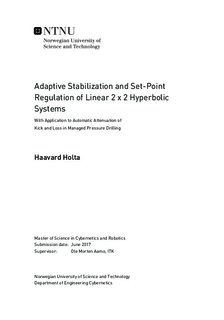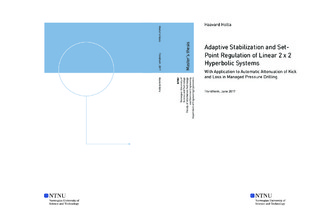| dc.description.abstract | Linear 2 x 2 hyperbolic partial differential equations can be used to describe many real-world problems and have attracted considerable research interest in later years. This thesis considers adaptive set-point regulation of such systems by using the infinite-dimensional backstepping method. Two control methods are proposed. The first for a system where sensing is restricted to be collocated with actuation and anti-collocated with two unknown parameters in an affine boundary condition. The second for a system where sensing is non-collocated with actuation and where the uncertain boundary parameters, anti-collocated with actuation, appear in a bilinear form with two unknown parameters. Boundedness in the L2-sense and point-wise in space are proved. Convergence to the selected set-point at the left boundary is shown for both methods. Because the boundary parameters are unknown, the steady state solution achieving this set-point is also unknown, transforming the problem to a tracking problem with a parameter-estimate-dependent tracking objective. The parameter estimates are generated by a parameter update law operating on linear parametric models relating the system state estimates, measurements and boundary parameters.
The theory is applied to the Kick and Loss Detection and Attenuation Problem in Managed Pressure Drilling, where the goal is to attenuate any sudden inflow into the well-bore or outflow into the reservoir by controlling the bottom-hole pressure from top-side actuation. In addition, the reservoir pressure and the relation between pressure difference and net inflow are unknown. Simulations show that compared to using constant top-side actuation, the derived methods provide a significant reduction in total inflow and convergence time before the kick/loss is completely attenuated. The method using non-collocated sensing performs marginally better than the method only using collocated sensing and control in terms of less overshoot and oscillations. The difference, however, is insignificant for the tested parameter values. Both methods are able to attenuate the kick/loss in a time close to the theoretical constraint imposed by the bottom-hole -- top-side -- bottom-hole propagation time. | |

